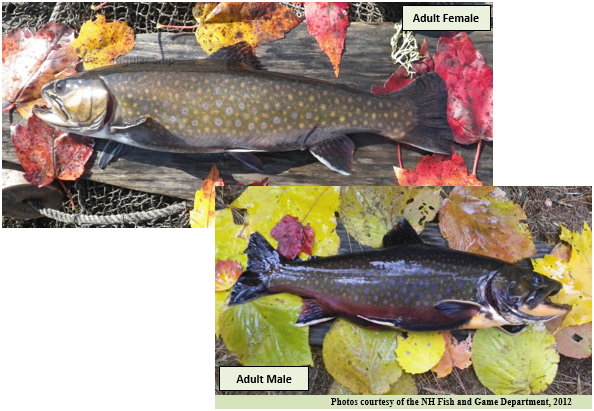Brook trout basics
Brook Trout (Salvelinus fontinalis)

Life History and Habitat Needs
Geographic Range: Brook trout (Salvelinus fontinalis) are the only trout native to much of the eastern United States. They have inhabited the East’s coldwater streams and lakes ever since the retreat of the continental glaciers across New York and New England, and they have thrived in the ancient valleys of the Appalachians for the last several million years. Arguably the most beautiful freshwater fish, brook trout survive in only the coldest and cleanest water. In fact, brook trout serve as indicators of the health of the watersheds they inhabit. Strong wild brook trout populations demonstrate that a stream or river ecosystem is healthy and that water quality is excellent. A decline in brook trout populations can serve as an early warning that the health of an entire system is at risk. Brook trout are a hearty, cold-water species that can inhabit a wide variety of environments. They can be found in small streams, rivers, beaver ponds, and large lakes. Some states have anadromous populations, called salters that spend most of their adult life in salt water and return to fresh only to spawn. Although they are a cold-water species, they can tolerate a large range of temperatures from 0 – 22°C, but prefer 13 - 18°C.
Movement/Migration: Movements inshore and offshore are related to spawning behavior and water temperature. If the habitat becomes too warm (>22ºC), brook trout will migrate to seek refuge. Deep pools and tributaries are the most common sanctuaries. If the river habitat is suitable for brook trout and they do not experience any stressors throughout the year, they tend not to travel large distances. Most of the populations existing in larger rivers act this way. They do not move until the fall at the onset of spawning. Even then, if the river has adequate habitat diversity, they tend not to travel large distances. Other populations have adapted to various river conditions. They travel very large distances (>120 km) in search of thermal refuge and/or spawning habitat. Some spawn in the main stem of rivers, while others utilize tributaries. Lucastrine (lake) populations move around the lake throughout the year in search of forage and spawning.
Spawning: Spawning occurs sometime between September and October and is dependent on water temperature. Maturity is usually attained at age 2 but can occur at age 1 in small streams where the trout tend to remain small due to the available habitat. Females will make a depression in the gravel substrate using their tail. This depression is called a redd, or nest. She will defend her redd during construction and pair up with the dominant male, who will also play defense with her. Often times this defense is to push off precocial subdominant males. When she has completed construction, the male and female join together side by side and release eggs and milt, sperm, simultaneously. The free floating, non-adhesive eggs fall into the depression in the substrate. She then moves slightly upstream and begins the process all over again. She continues to build redds until she is void of eggs, each time moving upstream so the sediment from construction falls onto the previously built redd and affords those eggs protection. She then migrates to deeper water for the winter. The males do the same. Both males and females are not monogamous and will mate several times before moving to winter habitat. The males tend to arrive later to the spawning area than the females and usually leave earlier. The fry tend to emerge sometime between February and April, again depending on water temperatures. They will inhabit areas that provide protection and forage, such as vegetated areas and pockets in between larger substrate until they are large enough to fend for themselves.
Habitat Use: Brook trout are specific in their habitat selection at different stages of their life. Habitat preference varies depending on other factors, such as temperature, dissolved oxygen, and food availability. Brook trout eggs are usually found in gravel depressions, influenced by groundwater. Stream flow in these areas is usually low to moderate. Larvae tend to seek out protected zones, which usually consist of pockets under and in between rocks and highly vegetated areas. Nursery habitat for larvae and juveniles includes littoral and sublittoral zones in lakes and ponds, where submerged aquatic vegetation and macroalgal beds provide important nursery habitat. Juveniles rely on several different substrate and habitat types, including cobble and boulder stream bottoms, small undercut banks and pools. As they become adults, they tend to start choosing habitats that fit their size and afford protection from predators (e.g. deeper pools and larger undercut banks that provide). Lake populations do the same, moving deep to afford protection from predators and thermal stress. Both stream and lake populations move throughout various habitats in search of food.
![]()
Fun Facts
State Fish:
The brook trout is the most common state species in the United States and is recognized in 10 states.
They Change Color During Spawning Season:
Although they are characteristically colorful and distinctive, another of the interesting facts about male brook trout are the colors displayed during spawning season. Male side-markings can change to a golden brown, scarlet red, royal blue, emerald green and bright florescent orange. This change in color plays a significant role in spawning; the brighter colors change for attracting female brook trout. The brighter the color range, the more females are attracted. (http://www.ospreylakelodge.com/3-fun-facts-about-brook-trout/)
![]()
Document Actions





